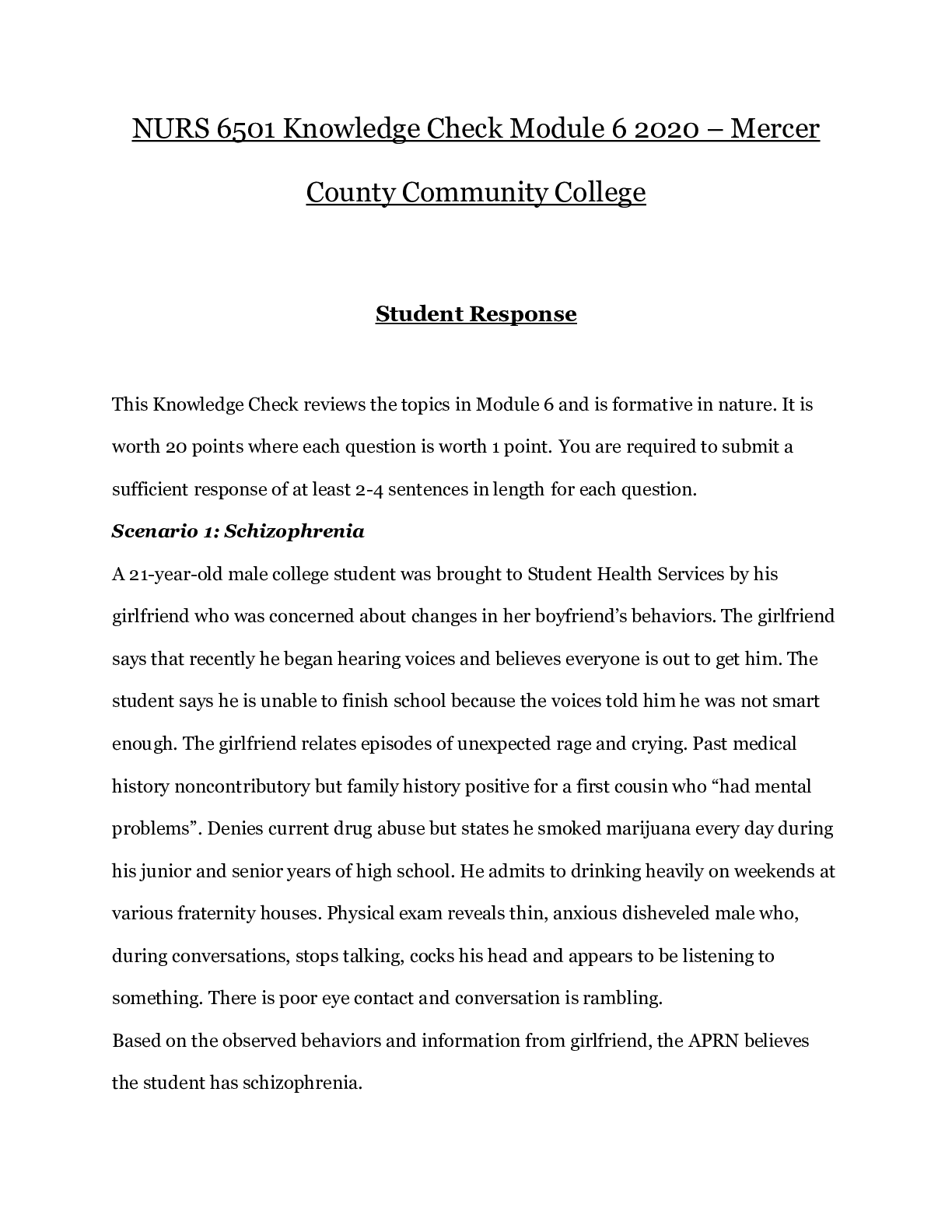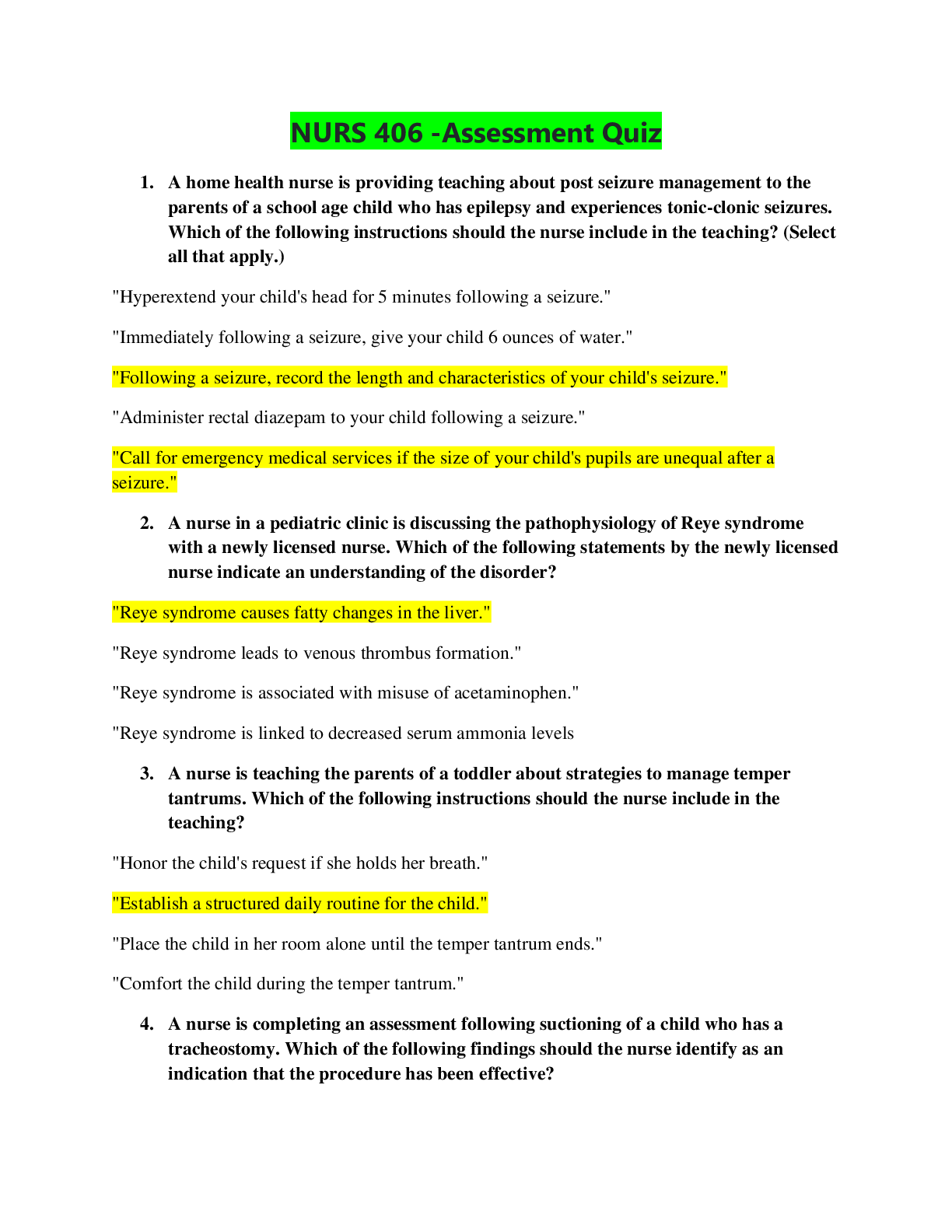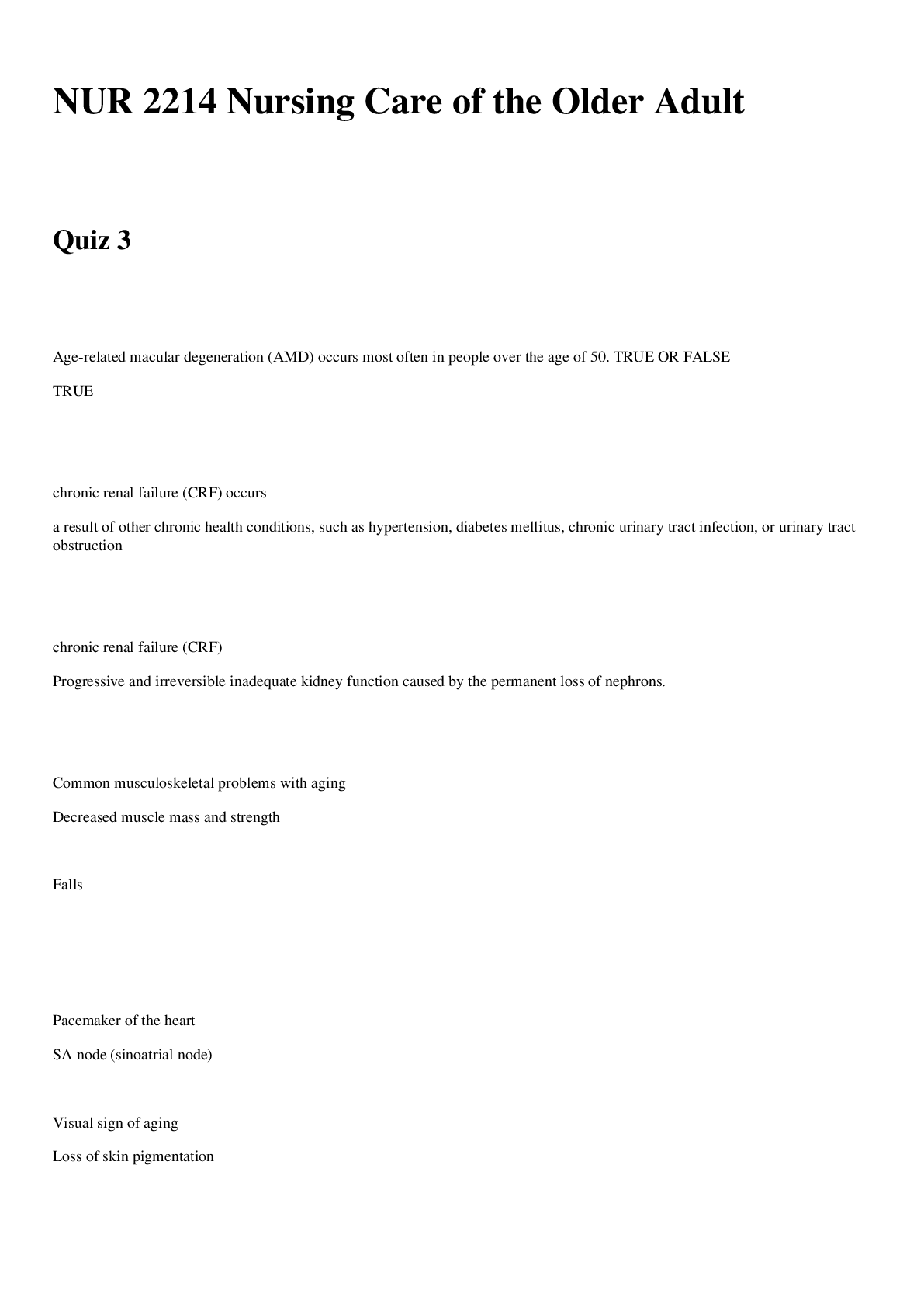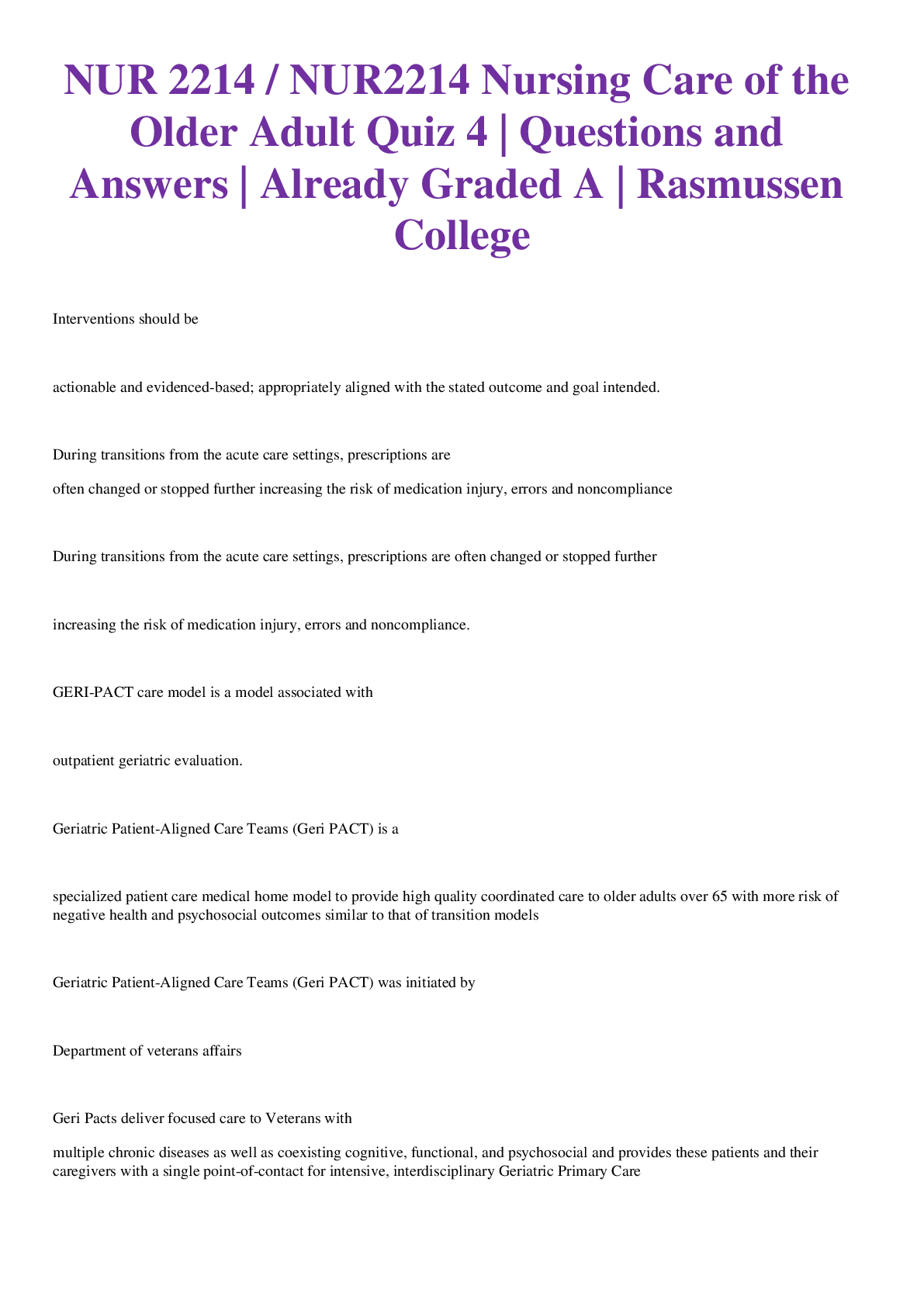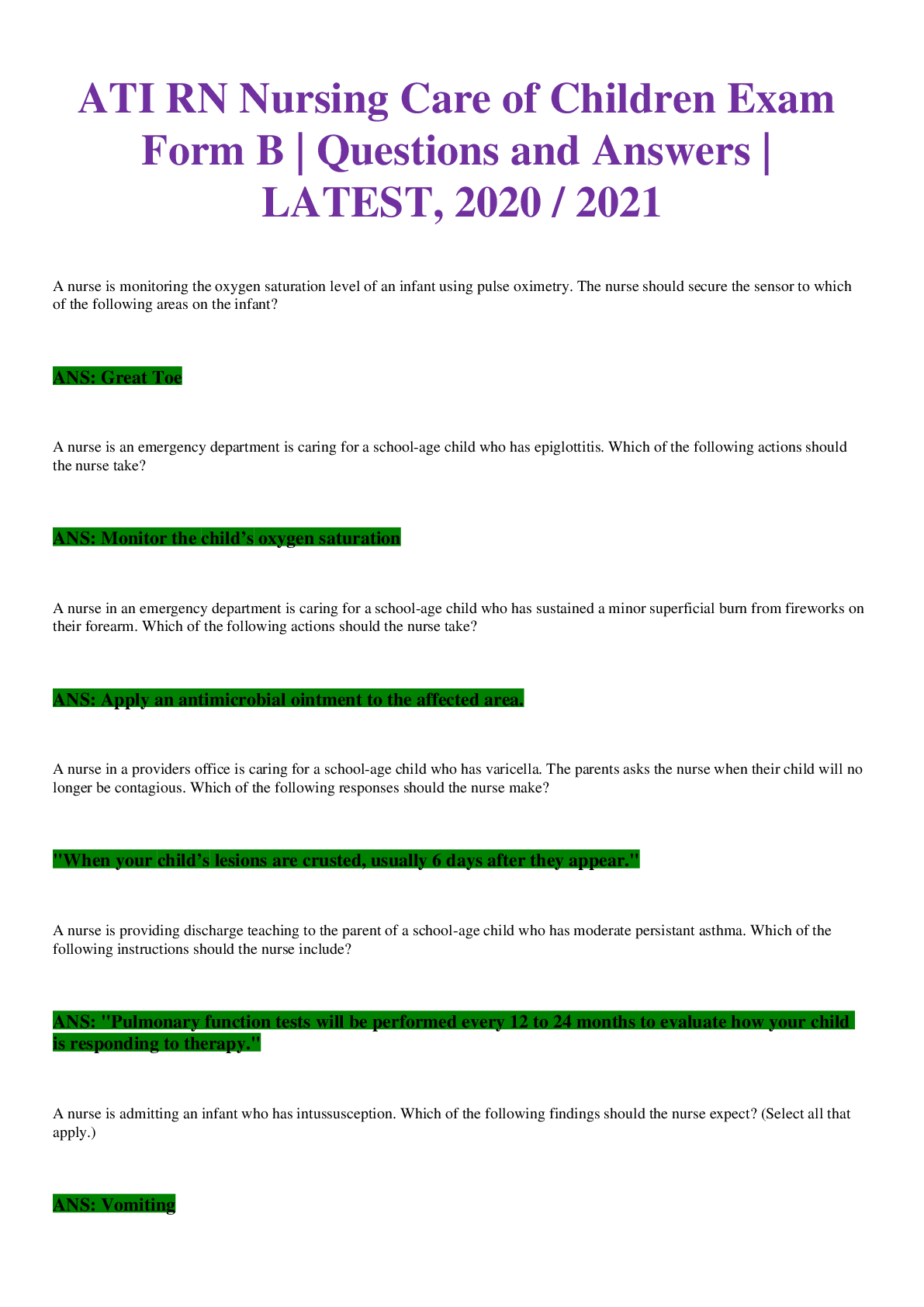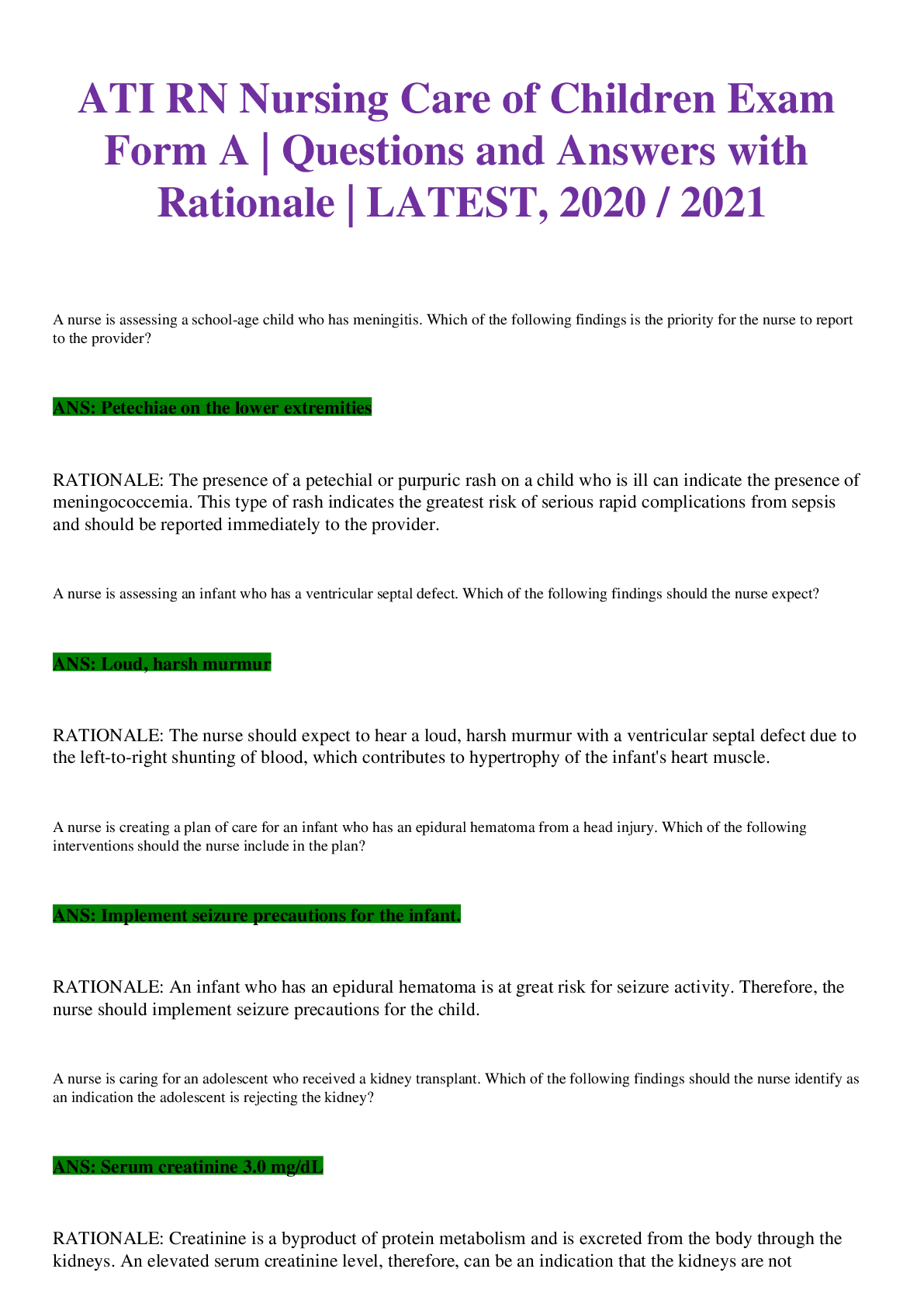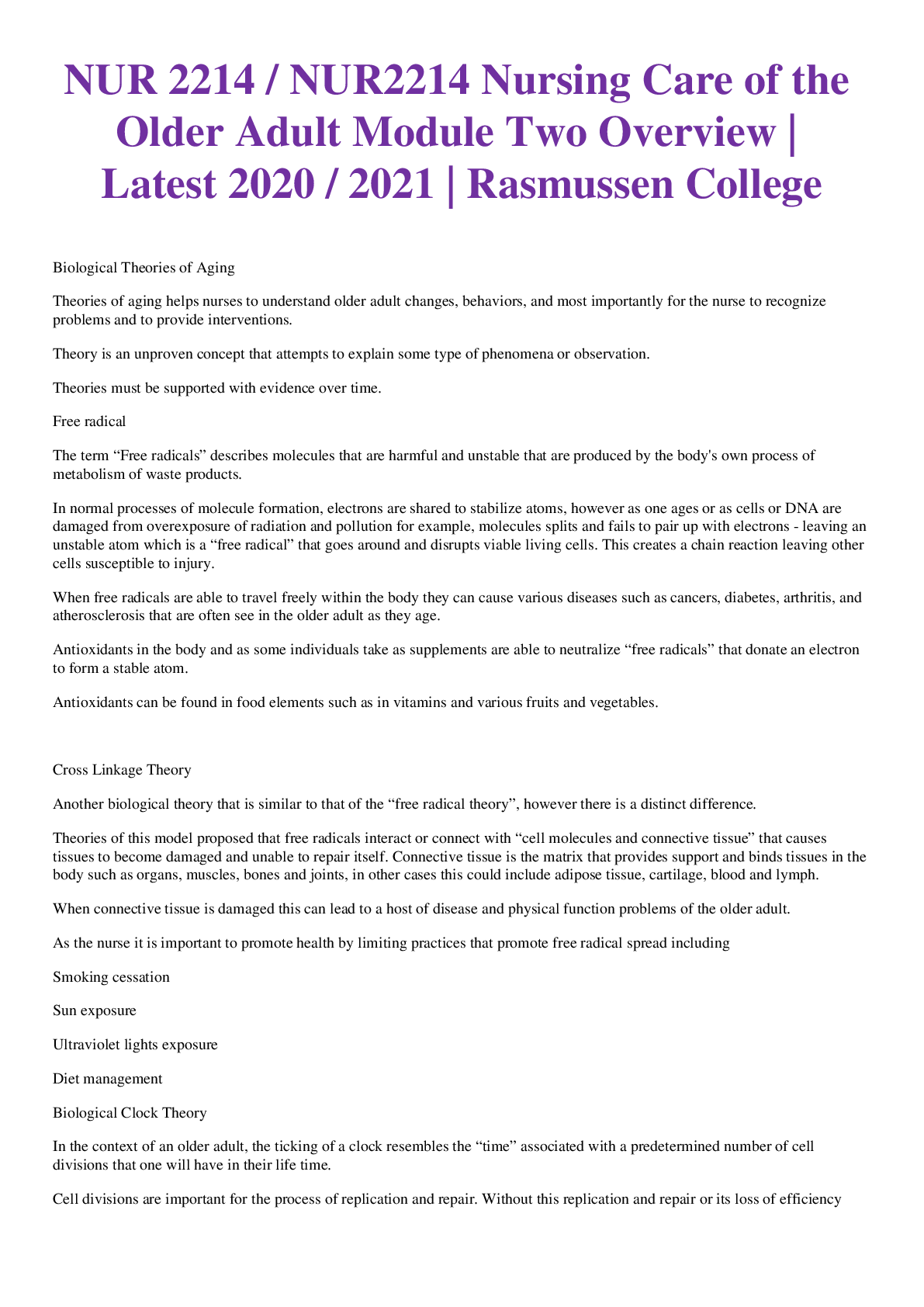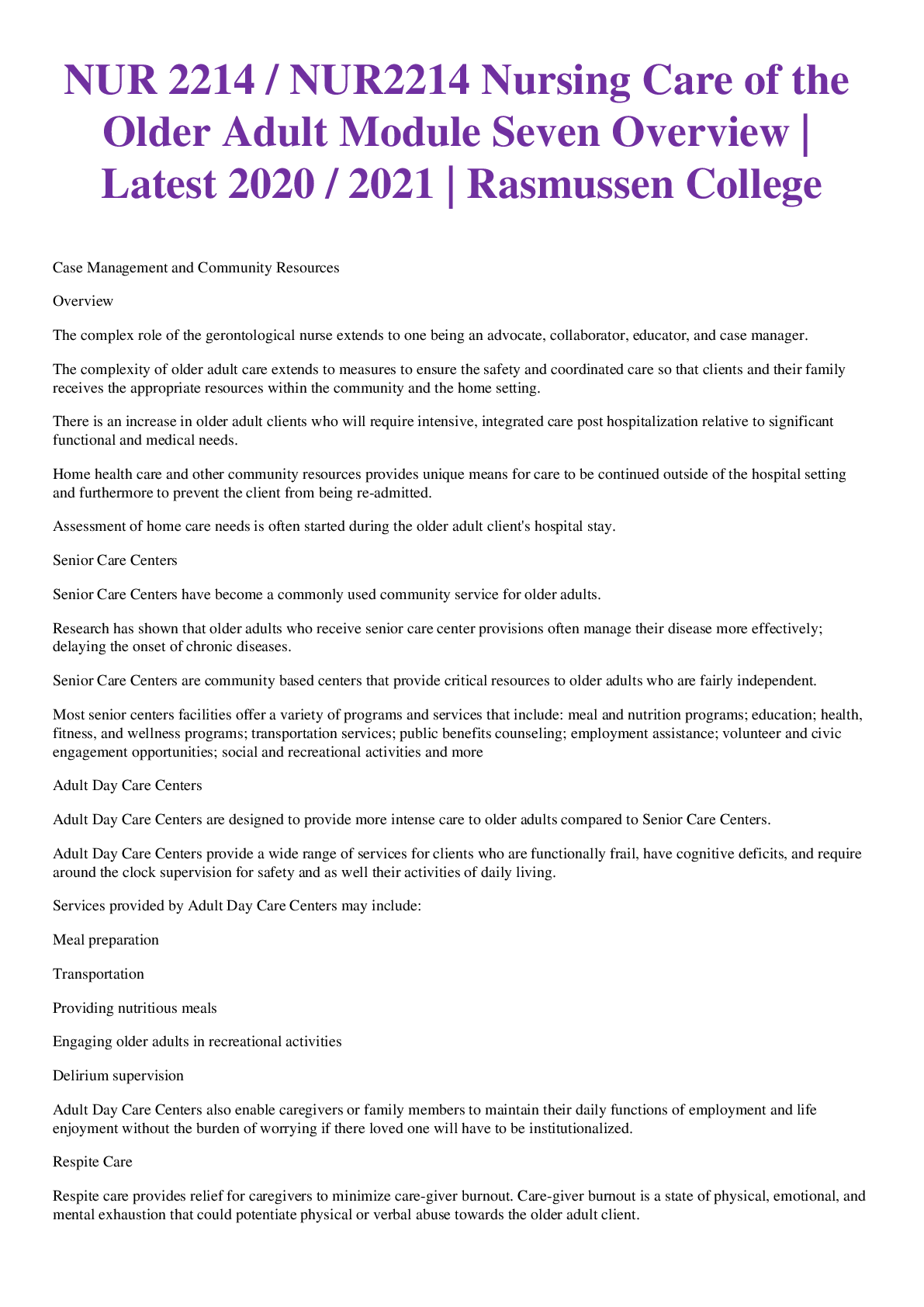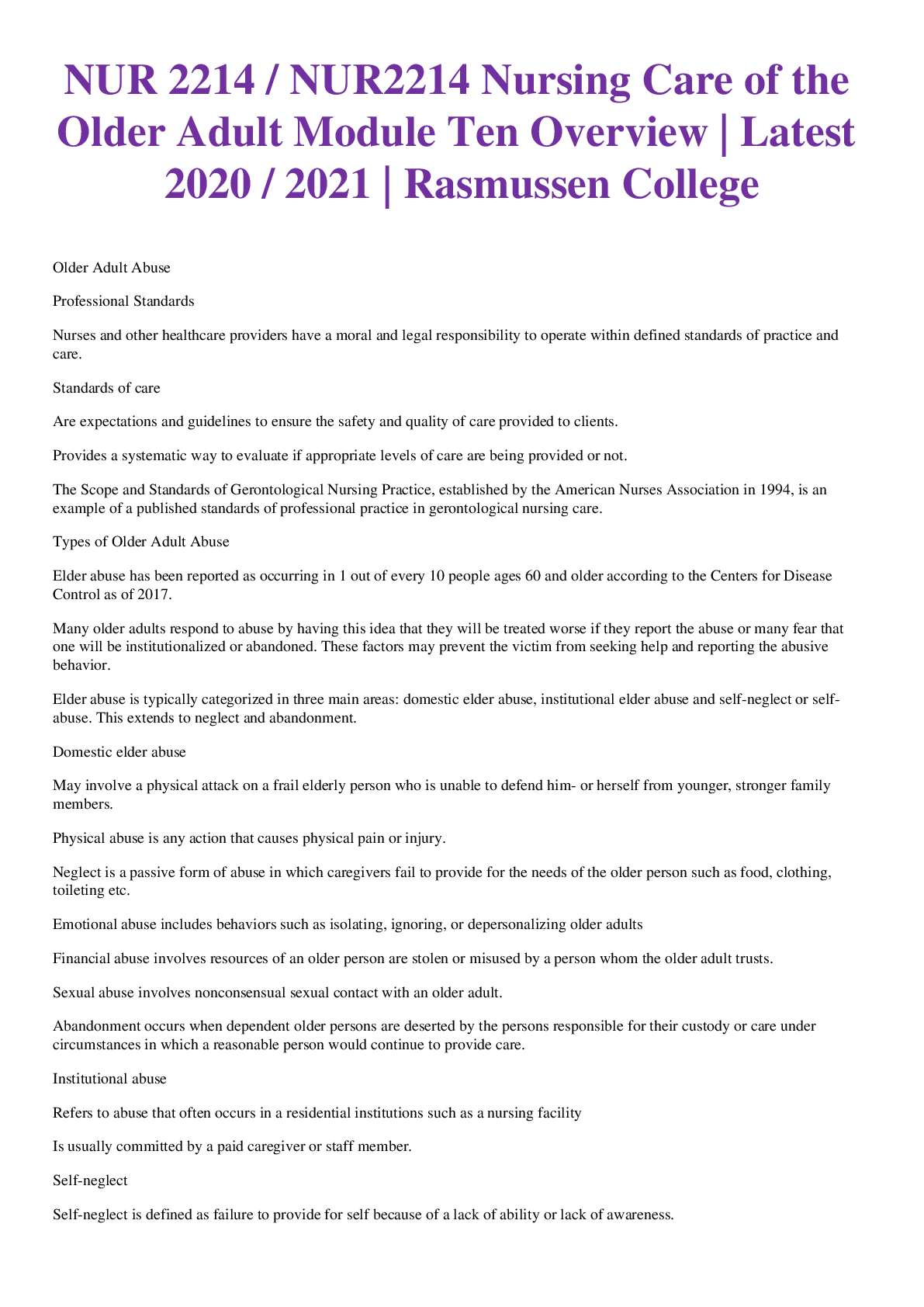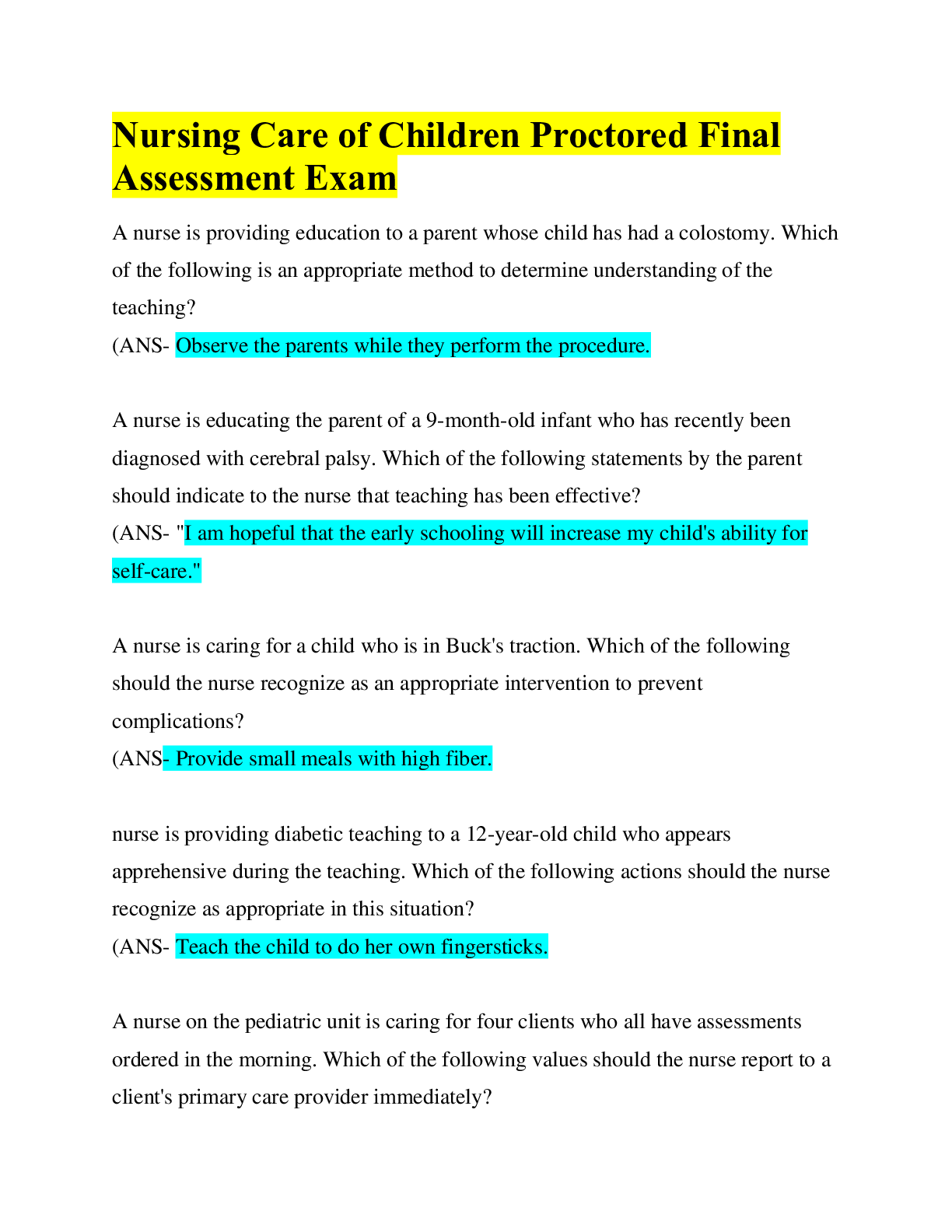*NURSING > EXAM > NSG 300 Nursing care of Children 1 ATI – Our lady of Holy Cross College / NSG 300 Nursing care of (All)
NSG 300 Nursing care of Children 1 ATI – Our lady of Holy Cross College / NSG 300 Nursing care of Children 1 ATI
Document Content and Description Below
NSG 300 Nursing care of Children 1 ATI – Our lady of Holy Cross College. Nursing Care of Children 1 1. A nurse is caring for a dehydrated toddler who must receive 100 mL of normal saline over ... the next 4 hr. Using a 60 gtt microdrip set, what rate should the nurse regulate the IV to deliver. a. 25 gtt/min b. 15 gtt/min c. 60 gtt/min d. 100 gtt/min 2. A nurse is assessing a 9-month old infant for potential developmental delay. Which of the following observations should the nurse expect to find to support this condition? a. Delayed startle reflex b. Inability to sit without support c. Powerlessness to pull self up d. Inability to stand alone 3. The nurse is assessing a 4-month old infant in the well baby clinic. Which of the following assessments should prompt the nurse to conduct a further evaluation? a. Head lag when pulled from lying to sitting position b. Disappearance of the Moro and tonic neck reflex c. Ability to hold a rattle but an inability to pick it up d. Infant can roll from back to side, but not back to front 4. A nurse is performing a physical assessment on a 6 month old infant. Which of the following reflexes should the nurse expect to find at this age? a. Stepping b. Babinski c. Extrusion d. Moro 5. A nurse is caring for a 4-year old child who has been admitted to the hospital. Which of the following would be the appropriate toy for the 4-year-old child? a. Brightly colored mobile b. Plastic stethoscope c. Jigsaw puzzle d. Beads and string 6. The nurse is caring for a 3-year-old child newly diagnosed with diabetes mellitus. When writing the care plan, the nurse includes this goal: the child will be provided with opportunities for therapeutic play. Which of the following would be the most appropriate toy to help meet this goal? a. Puppet dressed as nurse b. Book about hospitalization c. Doll and a syringe with no needle d. Stuffed bear with bandages to apply 7. A nurse is taking a history during a routine physical examination. Which of the following would be appropriate to tell the parent? a. Establish a set bedtime and follow a nightly routine b. Encourage active play prior to bedtime to tire the child c. Let the child stay up until tired enough to go to sleep d. Reward the child with a cookie if bedtime is pleasant 8. A nurse is teaching a parent of a 12 month old infant about nutrition. Which of the following statements by the parent would indicate the need for further teaching? a. “My child can drink 4oz of juice each day.” b. “I should give my child cereal and apply slivers for a snack.” c. “My child should be introduced to the same food as the family.” d. “My infant should drink 2qt of skim milk per day.” 9. A nurse is caring for a child with bacterial endocarditis. The child will receive long-term antibiotics and will require a peripherally inserted central catheter (PICC). Which of the following statements would be appropriate for the nurse to state to the child’s parent? a. “The PICC line will last several weeks with proper care” b. “The public health nurse will rotate the site every 3 days.” c. “You will need to make certain the arm board is on at all times.” d. “Your child will go to the operating room to have the line placed.” 10. A nurse is caring for a 2 month old infant who is brought to the clinic for routine immunizations. Which of the following should the nurse administer. a. HIP (haemophilus influenza), Td (tetanus, diphtheria, HBV (Hepatitis B vaccine), IPV (polio) b. DTaP (diphtheria, tetanus, pertussis), MMR (measles, mumps, rubella), and IPV (polio). c. DTaP (diphtheria, tetanus, pertussis), HIB (Haemophilus influenzae type b), IPV (polio), and HBV (Hepatitis B vaccine). d. HIB (Haemophilus influenza), MMR (measles, mumps, rubella), Td (tetanus, diphtheria), and IPV (polio). 11. The nurse is caring for a 3 year old child who is postoperative following revision of a malfunctioning ventriculo peritoneal shunt. Which of the following would be an appropriate way for the nurse to determine if the child is in pain? a. Ask the parents if the child in pain b. Use the FACES scale to rate the pain c. Use the numeric rating scale d. Rely on vital sign changes, such as increased heart rate 12. A nurse is conducting a yearly health assessment of a 14-year-old girl. The nurse should understand which of the following findings will require further evaluation? a. She has acne vulgaris on her face b. She has not gained in height since her last visit c. Her menstrual cycle is irregular d. There is a lateral curvature to her spine 13. A nurse is caring for an 8 year old child who has fractured his femur. The child is in skeletal traction. To assist with the child's developmental needs, which of the following would be an appropriate action for the nurse to take? a. Allow the child to play video games daily. b. Take the child to the playroom daily, in the bed, maintaining traction. c. Assign roommates for the child who are of similar ages. d. Have the hospital tutor visit daily to assist the child with homework. 14. A nurse is teaching a parent of an 18 month old child about safety. Which of the following statements should indicate to the nurse that the parent understands the teaching? a. "I have locked my medications in the medicine cabinet." b. "I know that once my child understands ’no,’ my child will be safe." c. "I watch my child every second, so I’m sure my child can’t get into anything." d. "I will make my child vomit if she swallows anything poisonous." 15. A nurse is caring for a 2-year-old child who was found by his parents crying and holding a container of toilet bowl cleaner. The client’s lips are peeled and oozing, and he is drooling. Which of the following should be the nurse's highest priority? a. Monitoring the respiratory status of the child b. Determining the percentage of burned surface area c. Confirming the presence of a gag reflex d. Identifying the type of poisonous substance 16. The nurse is caring for an adolescent who is receiving pain medication via a PCA pump. When the nurse assesses the client’s pain at 8 a.m., the client describes the pain at level 3 on a scale of 1 to 10. At 10 a.m., the client describes the pain at level 5. The nurse discovers the client has not pushed the button to deliver the medication in the past 2 hr. Which of the following actions would be appropriate for the nurse to take? a. Ask the physician to discontinue the PCA so the nurse can administer PRN pain medication. b. Suggest the client’s parent push the button for the client if the parent thinks the child has pain. c. Assess the client again in an hour because a pain level of 5 is acceptable on a scale of 1 to 10. d. Reinforce teaching about how to push the button to deliver the medication with the client. 17. A nurse is caring for a 3-month-old infant admitted with suspected non-organic failure to thrive (FTT). Which of the following statements is true regarding non-organic failure to thrive? a. Inability to tolerate lactose-based formula b. Disruption in the parent-child bond c. Inborn error of metabolism d. Gastrointestinal malabsorption disorder 18. A nurse is caring for a 12-year-old adolescent who has ingested 60 mL of bleach. Which of the following statements by the nurse would indicate an understanding of this ingestion? a. The absence of oral burns excludes the possibility of esophageal burns. b. Acidic substances have the same effect as alkaline substances. c. Oropharyngeal damage is more common with liquids than with solids. d. The severity of alkaline burn depends of the pH of the substance. 19. A nurse is performing an assessment on a child at the clinic. When performing this assessment, the nurse should do which of the following? a. Have the child lie down, examine the head and proceed downward with the examination. b. Have the child sit in the parent's lap, auscultate the heart and lungs, and then examine the ears and throat. c. Have the child lie down, examine the throat and ears and then auscultate the heart and lungs. d. Have the child sit in the parent's lap, examine the ears and then take the blood pressure and auscultate the heart and lungs. 20. A nurse is caring for a 2-year-old child with cystic fibrosis. The nurse is planning to take the child to the playroom. Which of the following activities would be the most appropriate for the child? a. Cutting and gluing. b. Blowing soap bubbles. c. Riding a tricycle. d. Building block towers. 21. A nurse is caring for an 18 month old toddler who has been admitted for lead poisoning. An order for a urine specific gravity is written. Which of the following would be the appropriate way for the nurse to collect the urine? a. Applying a pediatric urine collector b. Obtaining a syringe to extract urine from the diaper c. Obtaining a catheter d. Catching the urine mid-stream 22. A nurse is providing education for a group of parents. A parent is concerned about the development of her 4-year-old child's fine motor skills. Which of the following should the nurse explain to be an expected skill for this age group? a. Copying a square and circle b. Tying shoelaces c. Beginning to use cursive writing d. Printing their name clearly 23. A nurse is teaching a new parent about infant nutrition. The nurse should realize teaching has been effective about food allergens when the parent indicates which of the following food choices as a common allergen in infants? a. Cow’s milk b. Wheat bread c. Corn syrup d. Egg yolks 24. A nurse is providing anticipatory guidance about accidental ingestion of a toxic substance to the parents of a toddler. Which of the following is an appropriate teaching point for the nurse to give the parents? a. Give the toddler milk. b. Get to an emergency facility. c. Call the poison control center. d. Induce vomiting. 25. A nurse is caring for a toddler who is scheduled for surgery. The parent asks the nurse for suggestions on how to prepare her child for the upcoming surgery. Which of the following would be an appropriate statement by the nurse to the parent? a. "You could read books to your child about being hospitalized." b. "You could explain the reason for the surgery." c. "You should avoid mentioning the hospitalization." d. "You should get new toys to help with hospitalization." 26. A nurse is performing a physical assessment on a 30 month old toddler. Which of the following nursing assessments should the nurse not expect to find at this age? a. Primary dentition is complete b. Legs appear bowed c. Birth weight is tripled d. Abdomen is pot-bellied 27. A nurse is working at an immunization clinic. Which of the following would be a contraindication to the pertussis immunization? a. History of fever of 101° F (38.3° C) after a previous immunization b. Sibling who had an adverse reaction to pertussis immunization c. Documented history of egg allergy d. Known neurologic or seizure disorder 28. A nurse is caring for an infant on droplet precautions. The nurse understands that she can best prevent the spread of droplet pathogens by doing which of the following? a. Having the infant wear a mask in the playroom b. Wearing sterile gloves when changing the infant’s diapers c. Wearing a gown and mask when feeding the infant d. Using contact precautions when caring for the infant 29. A nurse is caring for a child who is dying. The child's 4-year-old sibling is visiting. Which of the following statements indicates a 4-year-old's perception of death? (Select all that apply.) a. Death is the same as going to sleep. b. Death is caused by magical thinking. c. Death is permanent and lasting. d. Death is the result of a wish. e. Death is a punishment. 30. A nurse is educating a parent of a toddler on development. Which of the following would be an appropriate response by the nurse? a. "Your child will begin to scribble spontaneously with a crayon by 30 months." b. "Your child will begin to scribble spontaneously with a crayon by 12 months." c. "Your child will begin to scribble spontaneously with a crayon by 24 months." d. "Your child will begin to scribble spontaneously using a crayon by the age of 18 months." 31. A nurse is observing an 8 month old infant and parent playing peek a boo. The parent asks the nurse if this game has any developmental significance. The nurse should indicate to the parents that playing peek a boo will develop which of the following concepts? a. Hand-eye coordination b. Basic trust c. Object permanence d. Egocentrism 32. A nurse is assessing an 8-year-old child's psychosocial development. Which of the following findings should the nurse recognize as requiring further evaluations? a. The child prefers playmates of the same sex. b. The child is very competitive when playing board games. c. The child complains everyday about going to school. d. The child has frequent disagreements with siblings. 33. A nurse is educating a teenage mother about the care of her newborn. When giving safety information, which of the following information should the nurse provide to the mother? (Select all that apply.) a. Utilize a walker for mobility. b. Move glass objects to a higher shelf. c. Turn the car seat so that it faces forward. d. Put a safety gate at the top of the stairs. e. Keep small objects out of reach. 34. A nurse is caring for an 18-year-old adolescent who is going away to college. The adolescent will be living in the dormitory. Which of the following is the most appropriate immunization to suggest that he receive? a. Pneumococcal polysaccharide b. Meningococcal polysaccharide c. Influenza d. Varicella 35. A nurse is performing a physical assessment on a 6-year-old child. Which of the following findings should prompt the nurse to conduct additional follow-up? a. Sparse, fine pubic hair b. Tonsils that touch each other c. Small, brown maculae d. A central incisor that is loose 36. A nurse is caring for a hospitalized 3 year old child who the parents report is toilet trained. Since admission to the hospital, the child has experienced bed wetting. Which of the following is an appropriate response by the nurse? a. "Let’s put a diaper on you to help you stay dry." b. "I can’t believe a big child like you wet your bed." c. "Let’s get you cleaned up so you can go to the playroom." d. "If you do not wet your bed, you will get a reward." 37. A nurse is caring for a 3 year old child who has a lead level of 15 g/dL. When teaching the toddler's parent about nutrition and the correlation with lead poisoning, which of the following suggestions is appropriate for the nurse to state? a. Drink fluids of any kind. b. Drink water. c. Drink cranberry juice. d. Drink milk. 38. A nurse is caring for an infant who is crying. The nurse plans to administer a liquid medication. Which of the following administration methods should the nurse use? a. Administer the medication in one dose and hold the mouth closed. b. Place a needleless syringe in the buccal cavity. c. Mix the medication with the infant’s regular formula in a bottle. d. Administer the medication slowly while holding the nares closed. 39. The nurse is assessing a 6 month old infant in the well child clinic. Which of the following assessments would indicate the infant needs further evaluation? a. Child is able to sit unsupported for a few seconds b. Posterior fontanel is closed c. Legs stay crossed at the knees d. Birth weight has doubled 40. A nurse is administering the MMR vaccine to a child. Which of the following statements by the parent indicates an understanding of the vaccine? a. "I am not going to let my child play with other children for two days." b. "I will watch my child closely for any signs of seizures or convulsions." c. "I can give my child Tylenol for discomfort associated with the vaccination." d. "My child may have some discharge from the vaccination site." [Show More]
Last updated: 1 year ago
Preview 1 out of 10 pages
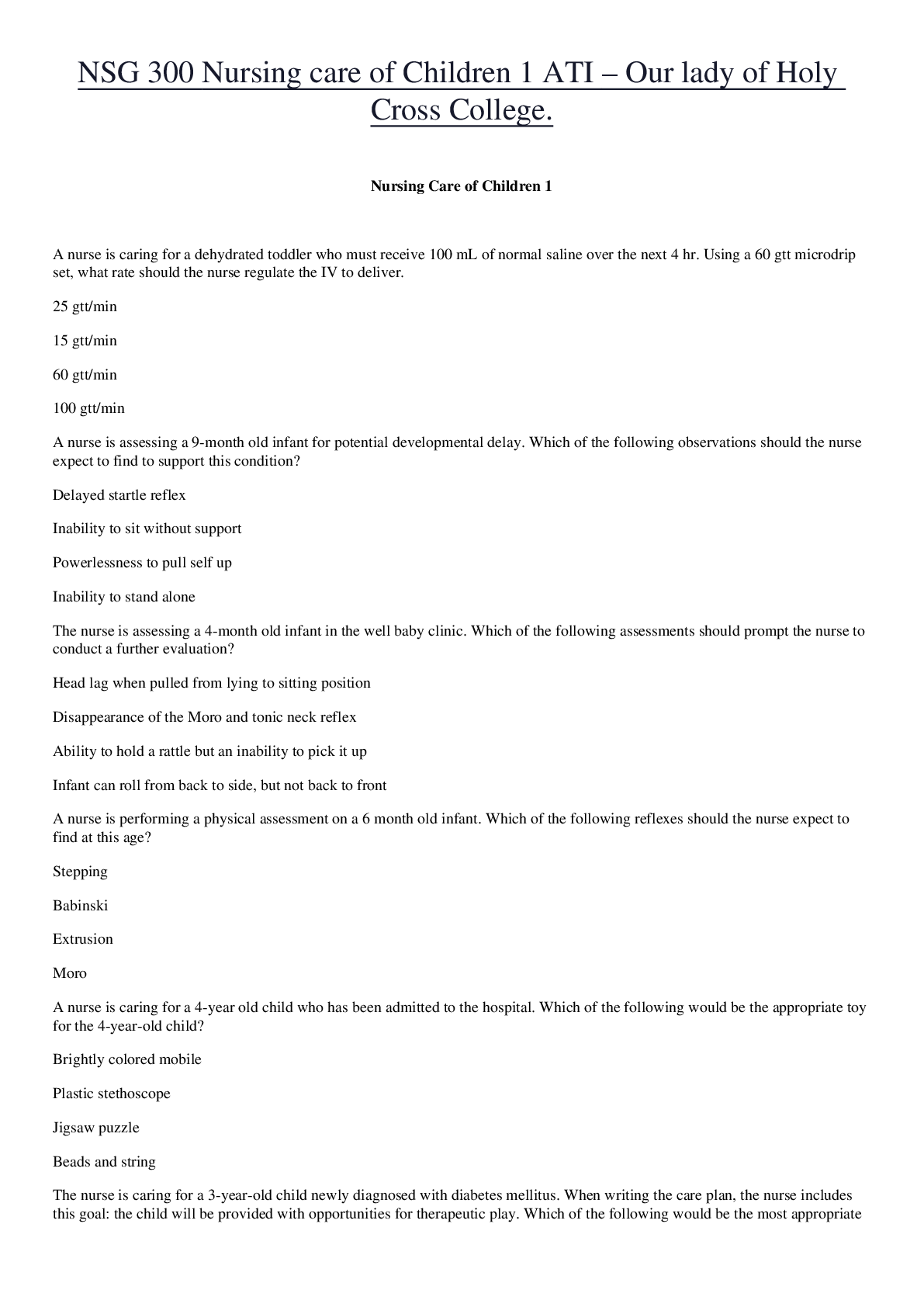
Reviews( 0 )
Document information
Connected school, study & course
About the document
Uploaded On
May 26, 2020
Number of pages
10
Written in
Additional information
This document has been written for:
Uploaded
May 26, 2020
Downloads
0
Views
47














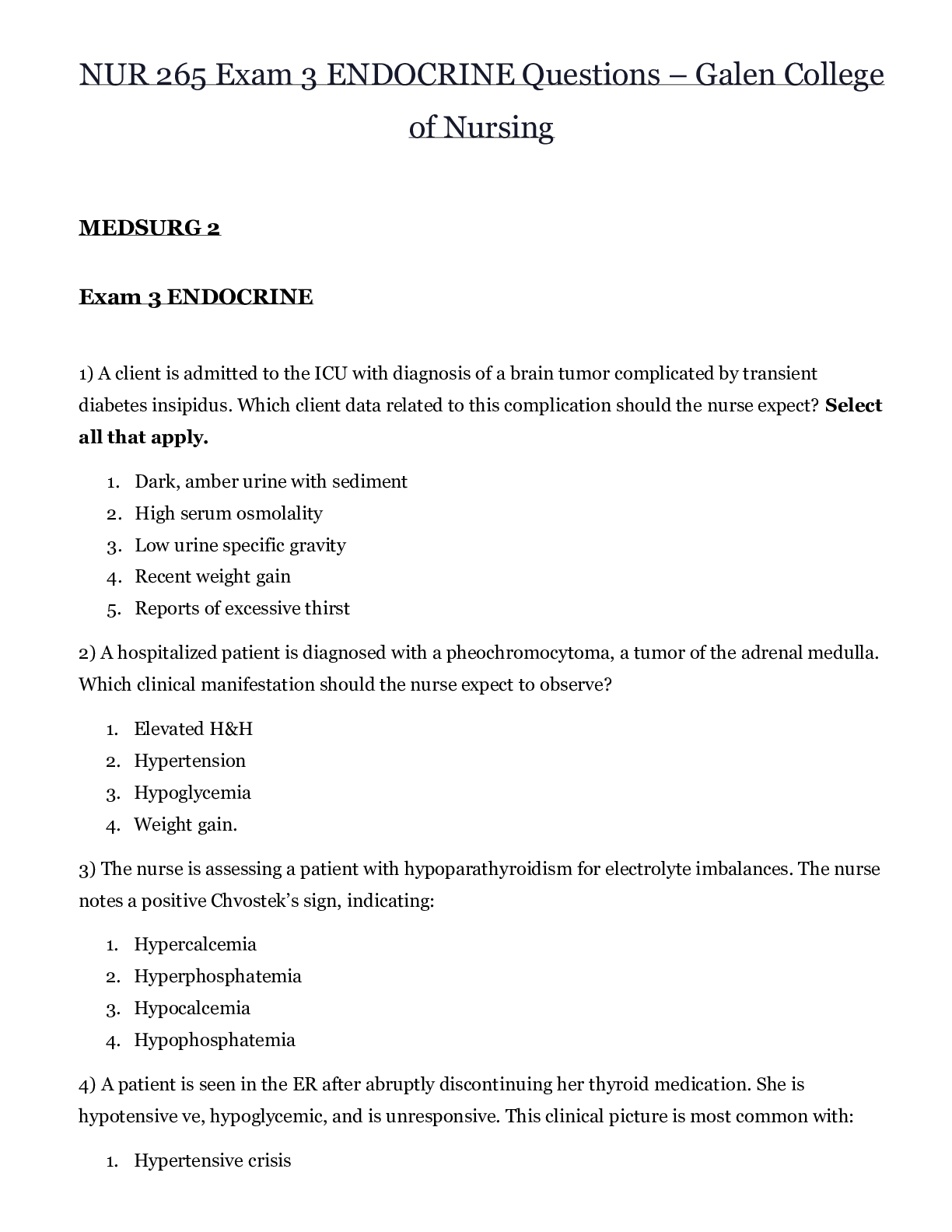
 – CHAMBERLAIN COLLEGE OF NURSING.png)
